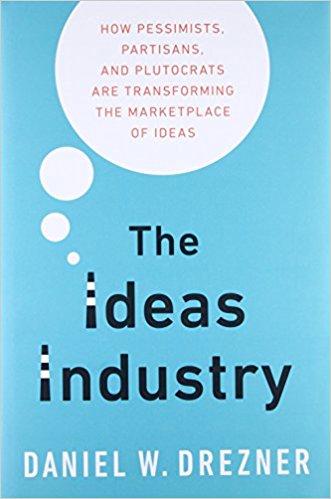You have /5 articles left.
Sign up for a free account or log in.
 The Ideas Industry: How Pessimists, Partisans, and Plutocrats are Transforming the Marketplace of Ideas by Daniel Drezner
The Ideas Industry: How Pessimists, Partisans, and Plutocrats are Transforming the Marketplace of Ideas by Daniel Drezner
Published in April of 2017.
What will higher ed look like in 2030?
After reading Daniel Drezner’s super excellent new book The Ideas Industry, I am now able to answer this question with the utmost of confidence and certainty.
The higher education system of 2030 will make the existing levels of 2017 postsecondary inequality look positively Amish. (Or Swedish, or Canadian - pick your egalitarian signifier).
The quality of the educational experience available to the most wealthy and the lucky talented few will improve at near exponential rates. The combination of learning science, amenities, technological advances, and market forces (not in that order) will continue to supercharge the elite postsecondary educational experience.
Students at high status well-endowed institutions will receive a high-touch personalized education built active and experiential learning. The role of technology will continue to expand at the best schools, but rather than replacing professors, technology will be leveraged to augment the work of educators and the process of learning. Blended, low-residency, and online education will continue to grow - but these technology enabled methods will be based on a foundation of relationships between experienced (and well-supported) educators and well-prepared and motivated students.
On the other extreme, 2030 will be the year that mass customization in higher education moves from aspiration to reality. Advances in artificial intelligence (AI) and virtual reality (VR) will enable the diffusion of high-quality digitally intensive learning and credentialing. Learning at publicly supported institutions will have largely moved from physical to digital spaces. The role of professors will shift from producers of teaching materials to that of a learning coach, with the level of individualized faculty coaching correlated to the price of the credential. This will mean that options for low-cost / low-human touch learning and credentialing will increase, resulting in both greater opportunity and greater stratification in the postsecondary market.
This vision, one of greater higher ed inequality made possible by technologies and market demand, is the sort of prediction that a thought leader might make. And as we learn from Drezner’s The Idea Industry, it is very good to be a thought leader.
The central thesis of The Ideas Industry is that the modern marketplace of ideas is tilted heavily in favor of thought leaders over public intellectuals. Thought leaders know a few things, and they waste no opportunities to proclaim these beliefs. The extent to which those paying the salaries of thought leaders - either directly with grants or high-status appointments or indirectly through attention and readership - is largely dependent on the confidence in which those ideas are asserted. Certitude matters more than accuracy.
Public intellectuals, conversely, are those academics and thinkers and writers who know a little bit about a great many things. They are willing to share their opinions on many aspects of our politics and our culture. At worst, a public intellectual is a “second hand dealer in ideas” (Hayek), and at best a challenger of the conventional wisdom.
An honest public intellectual will have lots to say about the future of higher education, but rather than offering a single definitive description of the the postsecondary world of 2030, they may put forth a number of scenarios.
My big takeaway from reading The Ideas Industry is that higher education needs more public intellectuals (particularly those coming out of the technology and learning community), but that those of us within that world would be better off shooting for thought leader status.
A related takeaway is just how difficult it would be for anyone spending their days thinking about the future of higher education to make it into the realms of recognized thought leadership. There is simply too much noise. Too many conferences. Too many tweets. Too many white papers. Too many blogs.
Moreover, as Drezner demonstrates, today’s most prominent thought leaders are often advancing the agendas of the already fortunate. The ability to translate scholarship into policy is largely dependent on access to capital. The ideas of think tanks and consultancies with the deepest pockets are likely to gather the most attention.
Daniel Drezner is a political scientist. His expertise is in international relations and security studies, and many of the examples that he draws on in The Ideas Industry are from his discipline. I would love it if Drezner would turn his analytical lens back on his own world of higher education. (He is a professor at Tufts, so this is his world).
What ideas would Drezner think will determine the future of higher education?
How does the marketplace of ideas about the future of postsecondary education drive our decision making today?
The Ideas Industry is a must read book for anyone even remotely interested in influencing where higher education will go in the next few decades. If you are interested in ideas and the spread of ideas, then you will love this book. If you are a merchant of ideas, then read The Ideas Industry as both a critique of your world and as a roadmap.
What are you reading?




